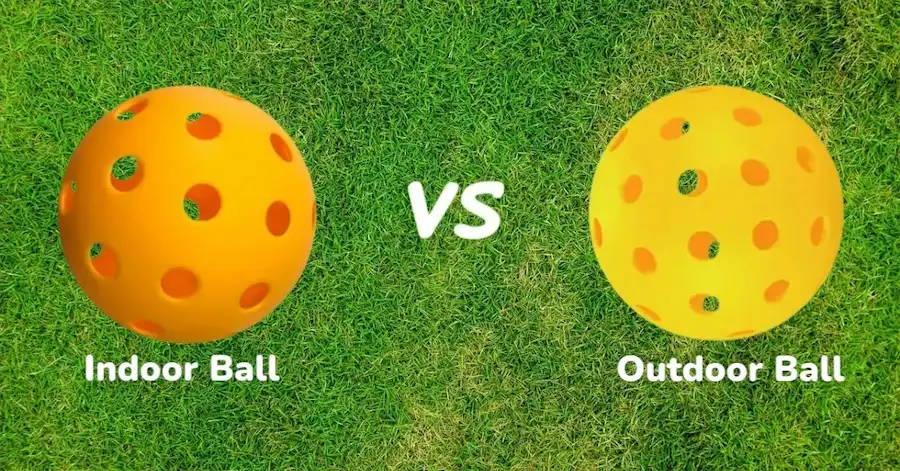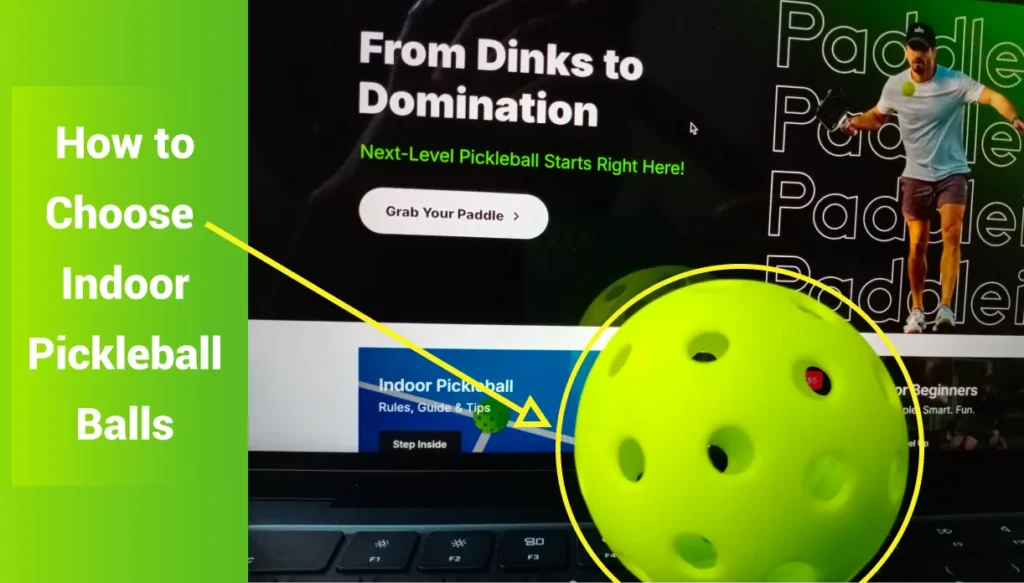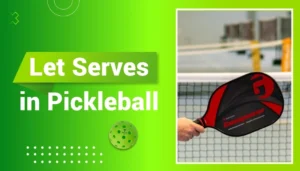When it comes to choosing the right indoor pickleball balls, it really comes down to a few key things: look for a ball with larger holes, a slightly softer plastic, and a weight that gives you control without bouncing all over the place.
Indoor balls are designed to grip smooth gym floors better, reduce skidding, and give you a more consistent feel with every shot.
I learned this the hard way—early on, I used outdoor balls indoors, and they just didn’t cut it. The bounce was unpredictable, and I felt like I had to adjust my shots constantly.
Once I switched to true indoor balls, like the Onix Fuse Indoor or Dura Fast 26, everything changed. The rallies were smoother, the ball responded better on dink shots, and I finally felt like I had control.
So if you’re tired of weird bounces or balls that just don’t feel right, trust me—getting the right indoor pickleball ball makes a huge difference.
Why Indoor Pickleball Balls Are Different
So, what’s the big deal with indoor pickleball balls? Why can’t we just use the same ball for indoor and outdoor games? Well, indoor pickleball is played in a totally different environment.
There’s no wind, and the court is usually smoother. That means the ball doesn’t need to be as heavy as an outdoor ball, and it doesn’t need to be as tough.
Indoor balls are actually softer and easier to control than outdoor ones. They have bigger holes, which makes them move a little slower and with more accuracy.
That’s really helpful when you’re playing on a smaller indoor court. If you’re playing indoors, you definitely want to get a ball that’s made just for that.
Key Features to Look for in Indoor Pickleball Balls
Alright, now that we know indoor balls are special, let’s go over the features you should look for when choosing one:
1. Material Composition
Indoor pickleball balls are made from softer plastics. You might see materials like polypropylene or low-density polyethylene on the label.
These plastics are softer, which means they’ll last longer on smooth indoor courts. This material also gives you more control because the ball doesn’t bounce as hard, making it easier to aim your shots.
2. Hole Patterns and Size
Indoor balls usually have 26 holes that are bigger than the ones on outdoor balls. Why? Bigger holes make the ball slower and give you more control.
If you’ve ever tried playing indoors with an outdoor ball, you’ve probably noticed it flies all over the place. Those big holes keep the indoor ball nice and steady, so you can focus on your game.
3. Ball Weight
Indoor balls are lighter than outdoor ones, weighing about 0.8 ounces. A lighter ball is easier to handle and doesn’t need as much force to hit. This helps you keep the game under control and allows you to play longer rallies, which is great for practicing your skills.
4. Durability
Here’s the thing: indoor balls don’t crack as easily as outdoor ones, but they can get soft spots over time. This happens because indoor balls are made from softer materials. So, while they might last a long time, they might start feeling “mushy” after a lot of play.
5. Color and Visibility
Indoor balls are usually bright yellow or neon green. These colors are easy to see on an indoor court, especially if the lighting isn’t the best. You want a color that stands out so you can keep track of the ball during fast rallies.
Outdoor vs. Indoor Pickleball Balls: What’s Different?

Outdoor and indoor pickleball balls aren’t the same, and here’s why:
1. Hole Patterns
- Outdoor Balls: 40 smaller holes to handle wind.
- Indoor Balls: 26 bigger holes for better control indoors.
2. Material & Durability
- Outdoor Balls: Made from harder plastic to last on rough surfaces, but they can crack easily.
- Indoor Balls: Softer plastic that’s great for indoor courts and less likely to crack, but might get mushy over time.
3. Weight & Control
- Outdoor Balls: Heavier for steady play in windy conditions but can be harder to control.
- Indoor Balls: Lighter, making them easier to control and perfect for longer rallies.
4. Color & Visibility
- Outdoor Balls: Bright colors like neon green or orange for easy visibility outside.
- Indoor Balls: Usually yellow or green to stand out on indoor courts, especially in lower light.
Each ball is designed for its environment, so pick the one that fits where you’re playing for the best game!
Top Performance Factors for Indoor Pickleball Balls
Now let’s get into how indoor pickleball balls perform on the court. These factors are what make a good ball really shine.
Control and Spin
Indoor balls are softer, so they’re easier to control. That means you can really work on spin shots. With no wind to worry about, your shots will be more accurate, which is super helpful for practicing tricky moves like topspin or backspin.
Bounce and Speed
Indoor balls bounce lower than outdoor ones. This is actually a good thing because it means you can play longer rallies and work on your placement. Since the bounce is more predictable, it’s also easier to practice your serves and returns.
Noise Levels
One cool thing about indoor balls is they’re a bit quieter than outdoor ones. Because they’re softer, they don’t make as much noise when they hit your paddle or the ground. If you’re playing in a shared space, this is definitely a plus!
Popular Indoor Pickleball Balls: Reviews and Comparisons
Let’s go over some of the best indoor pickleball balls out there. I’ve tested these and picked a few that I think are worth trying — especially if you’re just getting started with indoor pickleball.
GAMMA Photon Indoor Ball
- Pros: This ball has good bounce and speed. It’s almost like playing with an outdoor ball indoors, so it’s great if you like a faster game.
- Cons: It only comes in yellow, so it might be hard to see on certain court surfaces.
Franklin X-26 Indoor Ball
- Pros: This one is affordable and gives you solid control. It’s great for beginners who are still learning.
- Cons: It doesn’t give as much spin, so advanced players might want something more responsive.
Onix Fuse Indoor Ball
- Pros: It has a balanced feel with good visibility, which makes it a favorite for indoor play.
- Cons: Some players say it gets softer after a while, so it might lose its bounce over time.
Dura Fast-26 Indoor Ball
- Pros: This is a popular choice for tournaments because of its strong bounce and speed.
- Cons: It’s more expensive, so it might not be the best choice for casual play.
How to Choose the Right Ball for Your Skill Level
Not all indoor pickleball balls are the same. Here’s how to pick the best one for your level:
- For Beginners: Try the Franklin X-26. It’s easy to control and budget-friendly, so you can get used to the game without spending too much.
- For Intermediate Players: Go with the GAMMA Photon. It offers a nice balance of speed and control, which is great as you start to get more serious.
- For Advanced Players: If you’re playing in tournaments or really working on your skills, try the Dura Fast-26. It’s a top choice for its consistent bounce and speed.
Practical Tips for Buying Indoor Pickleball Balls

Testing Balls Before Buying
If you can, try out a few different balls before buying a bunch. Some local pickleball centers might let you test out different brands. This way, you can see which one feels best for your style of play.
Bulk Purchases
If you play a lot, buying in bulk can save you money. Sites like Amazon or Pickleball Central usually have deals on packs of balls. Just make sure you store them in a cool, dry place so they don’t wear out too quickly.
Choose Based on the Court Surface
Not all indoor courts are the same. If you’re playing on a wooden court, you might want a ball with more grip, like the Onix Fuse. For harder courts, the GAMMA Photon’s durability is a great option.
How to Take Care of Your Indoor Pickleball Balls
Taking care of your balls helps them last longer. Here are a few tips:
- Store Them Right: Keep your balls in a cool, dry place to avoid warping or cracking.
- Clean Them: If your balls are getting dirty, wipe them down with a damp cloth. This helps them keep their grip and bounce.
- Replace When Needed: If the ball starts feeling soft or doesn’t bounce well, it’s time to replace it. Using a worn-out ball can mess up your game.
Frequently Asked Questions
- Can I Use Outdoor Balls Indoors?
- You can, but it won’t be as good. Outdoor balls are heavier and bounce higher, which can make indoor play feel chaotic.
- What’s the Ideal Weight for an Indoor Ball?
- Most indoor balls weigh about 0.8 ounces. This weight helps with control and makes the game easier to manage indoors.
- How Often Should I Replace My Indoor Balls?
- It depends on how often you play, but a few times a season should be enough. They’re softer than outdoor balls, so they don’t crack as easily.
Finally
Choosing the right indoor pickleball ball isn’t complicated, but it can make a big difference in how you play. Whether you’re new to the game or looking to up your skills, picking the right ball can help you have more control and fun on the court.
So next time you’re ready to play, make sure you have the right ball, and get out there and enjoy the game!


